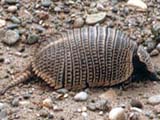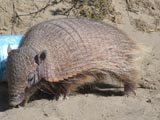Pichi
One species of pichi (Z. pichiy) is recognized. This animal is also known as the dwarf armadillo.
Zaedyus pichiy
Pichi or Dwarf Armadillo
- Range:
Argentina from the Provinces of Mendoza, San Luís and Buenos Aires south to the Río Santa Cruz; from the Atlantic Coast of Argentina west to the Andean grasslands of Argentina and Chile; found in Chile from Region V south to the Straits of Magellan.
- Size and Weight:
Head and body length: 260 — 335 mm (10.2 — 13.2 in).
Tail length: 100 — 140 mm (3.9 — 5.5 in).
Weight: Unspecified.- Description:
The shell is dark brown with whitish lateral edges, and the tail is yellowish. Posterior edges of the dorsal shell plates are thickly set with fine black hairs, and longer yellowish bristles are interspersed. The underparts are covered with coarse yellowish hairs. The claws on all feet are well-developed. Z. pichiy has small ears. The animal resembles Euphractus, but is more closely related to Chaetophractus.
- Habitat:
Z. pichiy digs burrows in open areas, on the base of small bushes on firm, sandy grounds.
- Ecology:
Z. pichiy draws in its feet to anchor the shell to the ground as a defense mechanism, like Chaetophractus. The animal shelters in shallow dens. The diet consists of insects, worms, and any small animal food it can find, including carrion. Z. pichiy is also reported to eat plant material, especially seed pods of the Prosopis tree. Z. pichiy is solitary. The animal has been reported to hibernate, at least in some localities. Local people prize the animal as a food item, and it is sometimes used as a house pet.
- Biology:
Z. pichiy breeds year-round. Gestation period is 60 days. One to three young may be born, although the number is usually two. Young are weaned at 6 months, and are sexually mature at 9 months to 1 year. One specimen lived 9 years in captivity.
- Pictures:
-
Do you have a picture of Z. pichiy that you would like to donate to this site? Please see the Armadillos Wanted page to see how you can help.
- Anatomical Images:
-
Anatomical specimens hosted by and © University of Kansas Natural History Museum / University of Michigan Museum of Zoology Animal Diversity Web; linked with permission.
Sources
Meritt, D.A., Jr. and K. Benirschke. 1973. The chromosomes of Zaedyus pichiy ameghino. Mammalian Chromosomes Newsletter 14: 108-109.
Nowak, R.M. 1999. Walker’s Mammals of the World, 6th edition. Johns Hopkins University Press, Baltimore, MD. 158-168.
Abbreviations
IUCN: International Union for Conservation of Nature and Natural Resources
USDI: United States Department of the Interior
CITES: Convention on International Trade in Endangered Species of Wild Fauna and Flora
 ] will leave this website.
] will leave this website.




